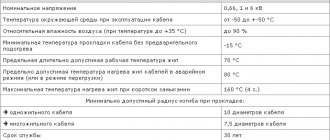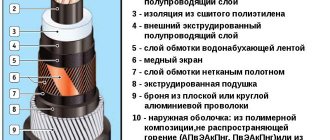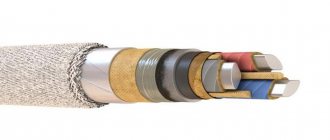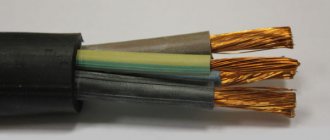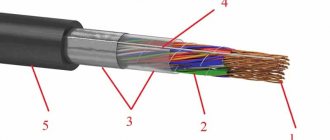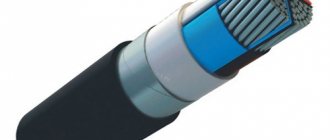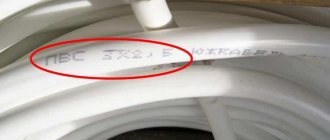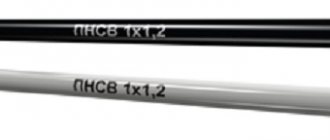The main component in the construction of power transmission lines are cable and conductor products. The AVVG cable is characterized by its low weight, simplicity and reliability of design. These useful qualities, along with low cost, determine the popularity of the product and its active use in various spheres of life - from household to industrial. The conductor successfully copes with the transmission of electricity in AC and DC networks.
Thanks to its technical parameters, AVVG can be used in any climatic zone of our country, and weather conditions do not affect durability and safety.
Technical characteristics of the AVVG cable
Unom - 0.66 to 1 and 6 kV.
Rated frequency - 50 Hz. Operating mode, t from -50 °C to +50 °C. Relative air humidity (at t0 +35 °C) – up to 98%; Service life: 30 years. Warranty: 5 years (from the date of start of operation). Carrying out installation work without preheating at temperatures from -15 °C and above. Tmax permissible core heating for devices: — during operation: +70 °C; — in emergency condition: up to +80 °C. — with a short circuit: +160 °C.
Rmin of bending during installation: - for single-core devices ? 15 external?; - for multi-core devices? 7.5 external?;
Construction length: - with a section of 2.5x16 mm2 - 450 m; — with a cross section of 25x70 mm2 — 300 m; - with a cross section of 95 mm2 and above - 200 m.
It is more clearly shown in the table:
Decoding the abbreviation AVVG
AVVG is an abbreviation that, in accordance with GOST, has a unique interpretation. Let's indicate the meaning for each letter:
- “A” – aluminum (material for manufacturing the current-carrying conductor);
- “B” (first) – PVC film (for core insulation);
- “B” (second) – PVC plastic for the outer shell;
- “G” – bare (the cable has no additional protection).
Often prefixes in the form of other letters are added to AVVG through a hyphen - for example, “T” or “P”. The first indicates that the wire is intended for use in the tropics (it copes well with mold), the second indicates that the product is flat. After the letter marking, numerical values can be written.
For example, AVVG-220 4*30 is an aluminum cable with core insulation and an outer sheath made of polyvinyl chloride, designed for operation in a 220 V network. It consists of four cores with a cross-section of 30 square meters. mm. The prefix “OZH” may be added in parentheses, which indicates that the cores are made single-wire.
Installation methods
- Closed gasket method
This method is the safest and most aesthetic. Installation is carried out on solid, non-flammable substrates (brick, concrete). The assembly is done using grooves into which the AVVG cable is placed, then the surface should be sealed. If it is laid on a flammable surface, it must also be secured. For these purposes, a box and a metal sleeve are used. You can use other materials, but not polyvinyl chloride. You can use an electrical cable with an increased level of fire resistance. For example, AVVGng or AVVGngp.
- Open laying method.
Types of AVVG cable
The area of application of the open method is surfaces that are difficult to ignite or non-flammable at all. It must be taken into account that the cable, which is not protected from damage, must therefore be covered with electrical metal pipes. Sometimes installation is carried out in an open area, for example, between two objects. Boxes are used for this. It is also possible to lay in places with high humidity, such as rivers, lakes, and mountainous areas.
Of course, the environment must be taken into account. The power of the cable must withstand the weight of the electrical cable. Thanks to the boxes, he is not afraid of temperature fluctuations and precipitation. It is not recommended to lay AVVG underground due to the lack of protection from mechanical and physical damage. The installation temperature should be above -15 degrees.
Testing the quality of AVVG in laboratory conditions
To confirm compliance with the stated technical and operational requirements, various quality control methods are used. It is best to have the cable tested in specialized laboratories.
First, its external condition is checked: make sure there are no cracks or other signs of mechanical damage. Next, the number of cores is counted in the section, the color of their insulation is recorded, after which the obtained data is compared with the information from the technical documentation attached to the product. Then more painstaking checks begin: the number of wires of each core is counted (if it is not a monolithic cable with the prefix “ozh”).
In the laboratory, they make sure that there are no breakdowns in the insulation and test it for strength. An ohmmeter and a multimeter allow you to determine resistance.
Outer diameters of cables for voltage 1 kV, mm
| Nominal cross-section of cores, mm2 | AVVG |
| 1x1.5 | 5,4 |
| 1x2.5 | 5,8 |
| 1x4 | 6,7 |
| 1x6 | 7,2 |
| 1x10 | 8 |
| 1x16 | 9,5 |
| 1x25 | 11 |
| 1x35 | 12 |
| 1x50 | 14 |
| 1x70 | 17 |
| 1x95 | 19 |
| 1x120 | 21 |
| 1x150 | 23 |
| 1x185 | 25 |
| 1x240 | 28 |
| 2x1.5 | 8,4 |
| 2x2.5 | 10 |
| 2x4 | 11,5 |
| 2x6 | 12,5 |
| 2x10 | 14 |
| 2x16 | 16 |
| 2x25 | 20 |
| 2x35 | 22 |
| 2x50 | 25 |
| 3x1.5 | 9,4 |
| 3x2.5 | 10,5 |
| 3x4 | 12 |
| 3x6 | 13 |
| 3x10 | 15 |
| 3x16 | 17 |
| 3x25 | 21 |
| 3x35 | 23 |
| 3x50 | 27 |
| 3x70 | 29 |
| 3x95 | 32 |
| 3x120 | 36 |
| 3x150 | 39 |
| 3x185 | 43 |
| 3x240 | 49 |
Analogues of power flexible cable products for flexible installation
| Foreign brand | Our brand |
| H07RN-F | KG, cold-resistant KG-HL, KGN*, KPGNT, KPRPST |
| H05RN-F | RPSh, RPShM |
| H05RR-F | PRM |
| H05RR-F | PRS, PRSn |
| H05VV5-F | PVSm |
| H05RN-F | PRM, PRMn |
| H01N2-D | COG |
| H05VV-F,OWY | PVS, PVSN |
| H05VVH2-F,OWYp | ShVVP, ShVVPn |
| H03VH-F | Ball screw, ball screw |
| NSHTÖU | KPG2U |
| FLRY | PVAM |
| HVTDU | KGE, cold-resistant KGE-HL |
| OLFLEX tr UCK 170 or OLFLEX tr UCK SPIREX | PGVA |
| H07V2-K, LgYc | PVA |
| NSSHOU | KGN |
| NSGAFOU | PRMT |
* - the most relevant analogue of the brand of imported cable product.
Selecting a cable for laying the electrical network
VVG power cable: technical characteristics and application features
Calculation of cable cross-section can be done manually using formulas, or use an online calculator.
Online calculator for calculating wire cross-section
It is also very important to consider the weight of the product when choosing the type of conductor. If the laying is done on the floor, then the weight does not matter much. If the installation is carried out by air, or the electrical wiring is fixed to the walls, then this parameter must be taken into account. Since aluminum is much lighter than copper, it is better to use an aluminum conductor for this option.
In addition, the weight is affected by the thickness of the conductor. The thicker it is, the better the wire will have throughput, but at the same time the product will have more mass.
Correctly selected cable and compliance with operating conditions guarantee long-term operation of the electrical system.
Step-by-step instructions for checking the integrity of cores and insulation
After transporting the cable and when accepting it from long-term storage, it is necessary to carry out a check. To do this, you need to use a tester (multimeter) with a dialing function. The check is carried out in the following order:
- By connecting the device wires to the corresponding sockets “com” - black, VΩ - red, the tester is put into working condition
- The switch is moved to the “ring” position
- By connecting the probes to each other, its serviceability is checked: a signal should sound
- Next, the cable cores are checked: the buzzer rings to indicate the presence of a circuit.
Checking the cable for the integrity of the cores and insulation using a tester
The last stage of the test is checking the insulation between the conductors. The probes touch the cores with different sheath colors. In a working product, neighboring wires do not “ring through.”
Electrical cable AVVGng
The decoding “ng” denotes a PVC shell with low flammability.
The structural elements of the AVVGNG cable are the same as those of AVVG LS. A conductor, which can be single-wire or multi-wire. Insulation consisting of PVC in white, yellow, blue, green, red, crimson, brown, black. A layer of winding that includes non-woven fabric. Shell with increased fire resistance.
The AVVGng device is used in the same conditions as AVVG, but also in explosive areas.
Cable design
The electrical product has a simple structure. Current-carrying conductors are made of high-quality aluminum. Their number varies from one to six. They can be single-wire (monolithic) or multi-wire. In the first case, the letter designation “ozh” is added to the marking. If these symbols are absent, then the cable is multi-wire.
The insulation has a specific color marking that corresponds to generally accepted international standards. The blue shell indicates the “neutral” conductor, yellow-green or brown – grounding, red – phase. If there are several phases in the cable, then other colors are selected - black, orange, green, purple, etc.
When constructing a diagram of the cross-section of an AVVG cable, a different color marking is used: red indicates the cable insulation, yellow indicates the core, black indicates the outer sheath.
Many product manufacturers add Mylar tape between the outer sheath and the rest of the cable. With its help, prompt, fast and safe removal of the shell is ensured. In a two-core cable, the cross-sections of the current-carrying cores are always the same; in other cases, the value may differ. Often, either the grounding or neutral conductor has a smaller cross-section, but in a six-core AVVG cable, both have a smaller cross-section.
Analogues of wired products for power lines
| Foreign brand | Our brand |
| AAS | A |
| WITH | M |
| AMKA-T | SIP-2t |
| AXKA | SIP1, SIP-1t, SIP2 |
| AXKA-T, NFA2X, TORSADE, NFC 33209 | SIP2 |
| ACSR, AACSR | AC |
| ALUS | SIPs-4 |
| ABC, AsXS, NFA2X | SIP4 |
| SAX, PAS-W | SIP3 |
| AsXSn | SIPn-4, non-flammable SIP-5ng |
* - the most relevant analogue of the brand of imported cable product.
Outer diameters of cables for voltage 0.66 kV, mm
| Nominal core cross-section, mm2, nx S | AVVG |
| 1x1.5 | 5,0 |
| 1x2.5 | 5,5 |
| 1x4 | 6,1 |
| 1x6 | 6,6 |
| 1x10 | 7,8 |
| 1x16 | 9,3 |
| 1x25 | 11 |
| 1x35 | 12 |
| 1x50 | 14 |
| 2x1.5 | 7,6 |
| 2x2.5 | 9,1 |
| 2x4 | 10,5 |
| 2x6 | 11,5 |
| 2x10 | 14 |
| 2x16 | 16 |
| 2x25 | 19 |
| 2x35 | 21 |
| 2x50 | 25 |
| 3x1.5 | 8,0 |
| 3x2.5 | 9,5 |
| 3x4 | 11 |
| 3x6 | 12 |
| 3x10 | 14,5 |
| 3x16 | 17 |
| 3x25 | 20,5 |
| 3x35 | 23 |
| 3x50 | 27 |
Weights of cables for voltage 0.66 kV, kg/km
| Nominal cross-section of cores, mm2 | AVVG |
| 1x2.5 | 35 |
| 1x4 | 45 |
| 1x6 | 55 |
| 1x10 | 80 |
| 1x16 | 115 |
| 1x25 | 160 |
| 1x35 | 200 |
| 1x50 | 260 |
| 2x2.5 | 75 |
| 2x4 | 97 |
| 2x6 | 120 |
| 2x10 | 170 |
| 2x16 | 220 |
| 2x25 | 330 |
| 2x35 | 400 |
| 2x50 | 560 |
| 3x2.5 | 90 |
| 3x4 | 120 |
| 3x6 | 150 |
| 3x10 | 220 |
| 3x16 | 290 |
| 3x25 | 440 |
| 3x35 | 550 |
| 3x50 | 760 |
Marking of power cables with PVC insulation
Now let’s take a closer look at the labeling of various modifications of the AVVG power cable, on the basis of which you can create a brief description of each product.
Symbolic marking
The first letter in the name of the electrical product does not change, so the cores of such a cable are made exclusively of aluminum. If this letter is not present (in other brands of wire), then the cores are made of copper.
In addition to AVVG, there are other modifications - AVVP, APVG, AVBbShv, APvBbShv, etc. Depending on the position, one or another letter indicates a certain design feature:
- The letter located in second place characterizes the material used to manufacture the insulation of individual cores. As written above, “B” is polyvinyl chloride, “P” is polyethylene, “Pv” (if the letter is lowercase, it refers to the capital one standing on the left side of it) is vulcanized polyethylene. Another feature is that if there is no “A”, the second character is in first place (ВВГ), which means that each letter of this list is shifted one position to the left.
- The symbol in the third position characterizes the material from which the sheath of the entire wire is made. “B” – polyvinyl chloride, “A” – aluminum, “BB” – armored protection made of steel or galvanized tape.
- The letter in the fourth position indicates the presence of additional protection on the cable. The symbol “G” indicates its absence, in which case the wire is called bare. The letters "Шш" indicate that the additional outer sheath is a polyvinyl chloride hose.
In addition to the symbols “T”, “P” and “ozh” the following meanings can be assigned to the abbreviation:
- ng – the product does not support combustion;
- LS – materials produced when burning emit a minimal amount of smoke and harmful gas;
- LTx – no evaporation of toxic or slightly toxic substances occurs during combustion.
Digital marking
From the example discussed above, it becomes clear: the first number after the letter designation indicates the rated voltage in volts. Sometimes it is indicated in kilovolts. Then the abbreviation looks like this - AVVG-0.22. Then follow the numbers characterizing the number of current-carrying wires and indicating their cross-section (they all have the same cross-section).
Weights of cables for voltage 1 kV, kg/km
| Nominal cross-section of cores, mm2 | AVVG |
| 1x2.5 | 39 |
| 1x4 | 55 |
| 1x6 | 60 |
| 1x10 | 80 |
| 1x16 | 120 |
| 1x25 | 165 |
| 1x35 | 200 |
| 1x50 | 270 |
| 1x70 | 340 |
| 1x95 | 430 |
| 1x120 | 530 |
| 1x150 | 630 |
| 1x185 | 760 |
| 1x240 | 970 |
| 2x2.5 | 85 |
| 2x4 | 115 |
| 2x6 | 135 |
| 2x10 | 175 |
| 2x16 | 230 |
| 2x25 | 340 |
| 2x35 | 420 |
| 2x50 | 580 |
| 3x2.5 | 105 |
| 3x4 | 145 |
| 3x6 | 170 |
| 3x10 | 230 |
| 3x16 | 300 |
| 3x25 | 450 |
| 3x35 | 560 |
| 3x50 | 780 |
| 3x70 | 1050 |
| 3x95 | 1350 |
| 3x120 | 1650 |
| 3x150 | 2000 |
| 3x185 | 2400 |
| 3x240 | 3100 |
Features of technical operation
AVVG is used in many areas of life. This is an indispensable electrical component when constructing distribution substations at industrial facilities and arranging switchboard local power lines. It is often used when laying wiring inside residential premises and production workshops.
During the installation and operation of the AVVG cable, it is necessary to ensure the absence of mechanical and compression damage, since the product is not protected by armored tape. The wire is highly sensitive to stretching, which can damage the polyvinyl chloride insulating layer. Thus, in the process of laying along walls or support pillars, it is necessary to ensure minimal sagging.
If laying in the ground is required, then you should buy a cable marked AVVGz. These products differ from conventional AVVG wires in a denser arrangement of cores. To reduce the free space, PVC plastic is added inside, which is also used to produce the outer shell. First, a trench is dug, then a sand cushion is created, and only then the cable is laid. After making sure that there is no tension, the route is covered with a layer of sand at least 150 mm thick.
Important! Regardless of the type of cable chosen, when laying in the ground, additional protection should be provided with warning tape. Its thickness and length are selected in such a way as to completely cover the cable, both in width and length. At points where a large load on the ground is permissible, the conductor is protected by a metal pipe.
The AVVGng cable is an ideal option for installing electrical networks at facilities with increased fire safety requirements, where non-flammable products are required. The prefix “ng” means no combustion even if the components are laid in bundles.
Where can I use it?
In the domestic sphere, AVVG cable with a small core cross-section is actively used - up to 6 square meters. mm. The presence of a double protective layer (core insulation and outer shell) allows the product to be used for open wiring without cable ducts. On the other hand, the plastic box retains its aesthetics, so it is still recommended for use. If you plan to organize hidden wiring, then the cable should be hidden inside the corrugation.
PVC plastic allows it to resist ultraviolet rays, so the AVVG cable can be placed even outdoors, in the open air. The design of the wire allows you to protect it from dust and moisture, so you can safely install electrical circuits in more humid rooms - basements, cellars and where there is a high probability of mold.
Advice! AVVG cannot be used in steam rooms, baths and other similar places, since the upper limit of the operating temperature range is +50 degrees. Celsius. As you know, the average air temperature in a steam room is approximately +90 degrees. Celsius.
Storage and transportation requirements
The cable is supplied and stored on special wooden drums. During the winding process, the ends of the wire are fixed on the “cheek” of the drum, which simplifies checking the product. The shelf life of AVVG depends on the conditions:
- outdoors – 2 years;
- under canopies in pavilions – 5 years;
- in specialized warehouses – 10 years.
Do not confuse drums with coils. However, AVVG can be transported and stored in the latter, but the weight of one must be up to 25 kg. Additionally, the coil is equipped with packaging that prevents arbitrary unwinding. Regardless of the choice, a label or technical passport is affixed to the product, which is hidden in a waterproof shell.
Application area
So, the purpose of the AVVG wire and its installation conditions. Now this conductor is used in the following electrical work:
- While laying the network over bridges, blocks and various overpasses.
- It can also be used in fire hazardous areas.
- The conductor is suitable for installation in flooded and damp areas.
- It can be used to lay power lines over the air.
Please note that this wire is not recommended for use when laying in the ground. After all, it is not armored, so even the slightest damage can disable it.

